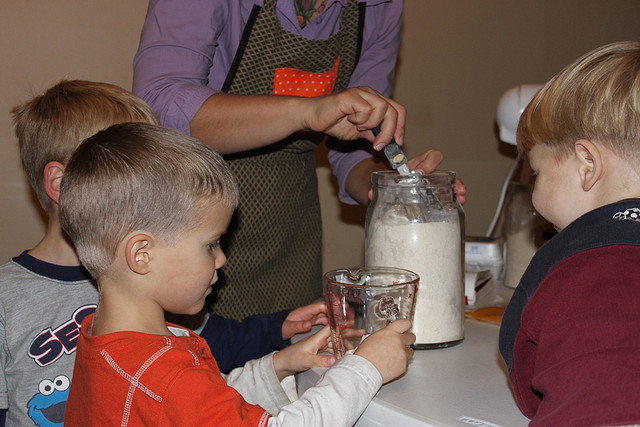We’re all about getting our kids in the kitchen—appreciating real ingredients, broadening their palates, building math skills, and observing chemistry in action—so sending them to camp to learn how to cook for a week sounds like a super idea…until you find out how much it costs (think $200 to $300 per week plus a supply fee). Before you toss out the idea altogether, why not band together with a group of friends to organize a DIY cooking camp? It’ll be easier on your pocket and you’ll have a say in what to cook and how to run it! Your very own DIY cooking camp is especially suited for kids with allergies and special dietary needs.
Don’t know where to start? Here are some tips and ideas.
Planning
1. Gather a group of three or four parent-and-kid pairs (or even visiting grandmas!) to take turns hosting the kids in your home kitchens over one week or two.
2. Come up with a schedule and try to stick to it every day (say, 9:00 am to 12:00 pm).
3. Design a menu of meals that is simple and fun to prepare, and, of course, tasty for the kids. Mix it up with a combination of baking, stove-cooking, grilling, and no-cook dishes and pick a fun theme like “Global Kitchens” or “Picnic Time!”
4. Develop a recipe template that all the moms can use to type up their recipes.
5. To make the experience feel like a real camp, include supplies and gear for each child:
- Aprons and/or toques (buy online or try your local art supply store). On day one, the kids can decorate them with fabric markers and gels.
- A binder to hold the printed recipes.
- A wooden spoon and plastic cutting mat.
The Menu
1. While one of the goals of cooking camp should be to encourage kids to explore new flavors, try and make dishes that kids are somewhat familiar with and would enjoy eating.
2. The plan is to keep the kids busy for a few hours so include a main course, side dish, and dessert for every lesson.
Ideas for mains include: mini pizzas, vegetable and meat kebabs, quesadillas, sushi, quiche, peanut noodle salad; side dishes: spring rolls, guacamole, arancini (rice balls), potato salad; and dessert: blackberry hand pies, watermelon granita, brownies, and berry and yogurt parfaits.
3. Come up with the menu together as a group to avoid duplication and divide up the shopping list. This way, you can save time and money by buying in bulk.
The “Curriculum”
1. Include a visit to a nearby farmers market, if possible, so the kids can meet the people who produce their food, be they farmers, cheesemakers, or beekeepers. They can also pick and choose the ingredients.
2. If you have a vegtable or herb garden, have the kids harvest some ingredients. There’s nothing like pulling a carrot out from the ground, soil clinging to its roots!
3. Plan dishes with steps that are fun for kids, especially hands-on (literally!) ones like rolling dough, skewering kebabs, cracking eggs, and cranking a pasta maker.
4. Teach different techniques like slicing vs. dicing, boiling, grilling, using a weighing scale, blender or food processor, as well as measuring (cups vs. ounces).
5. Explain processes and techniques as you go, and talk about the various ingredients that go into the dish.
6. Part of cooking with kids is teaching them kitchen safety. Here are some basics:
- Always wash your hands before handling food.
- Keep a safe distance from a hot stovetop and oven.
- Turn pot and pan handles inward toward the back of the stove to prevent accidents.
- Don’t sample raw eggs or meat.
- Let the kids practice cutting with a butter knife or a salad knife until they (and you!) are comfortable with a real knife.
Other Tips
1. Give the kids equal turns with gadgets, mixing, measuring, etc.
2. Don’t forget to give them a snack and play-break to re-energize.
3. Set aside a workspace—an island or a kitchen table—and have all the kids do the same thing whether standing on stools or sitting down.
4. Quiz them on what they’ve learned every now and then to keep them engaged and attentive.
5. Embrace the chaos and have fun!
Do you have tips for cooking with kids as a group or one-on-one? Please share!
— Pat Tanumihardja
Photos courtesy of Justycinmd, Carol Duncan, Rachel Tayse, and Coqui The Chef via Flickr.com











